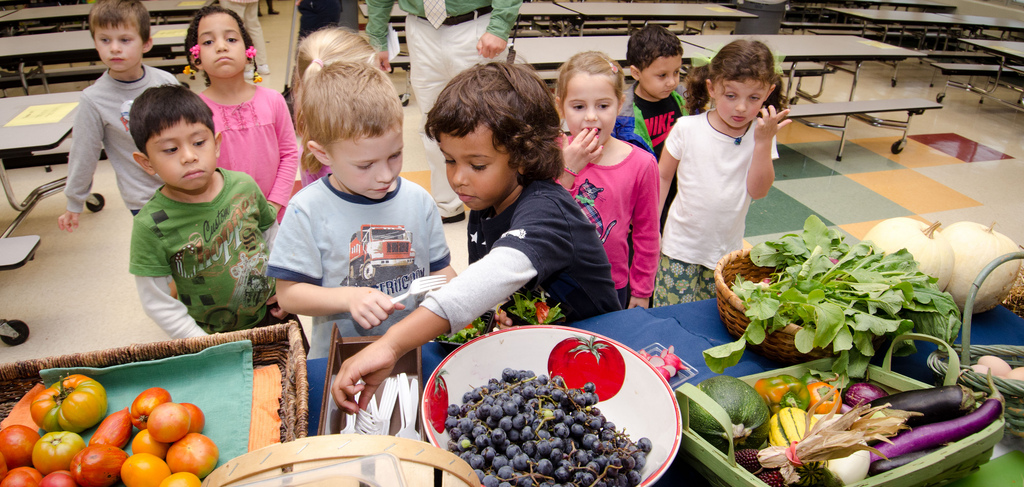By Emily Carver, Recent ASU Nutrition Student
This is part five of a five-part series on nutrition within the lifecycle. Read part one, part two, part three and part four.
Children truly blossom during the school-age years, and it’s such a beautiful thing to witness. These years cover a wide age range – between 5-12 years old – and are also referred to as “middle childhood” and “preadolescent years.” It’s in these years children are preparing for the physical and emotional rigors of adolescence, and when nutrition can positively and negatively impact both.

Students saw, touched and sometimes tasted produce that were new to them at Nottingham Elementary School in Arlington, VA, on Wednesday, October 12, 2011. Farmers from Bigg Riggs Farm in Hampshire County, WV, and Maple Avenue Market Farm in Vienna, VA were very popular with the students. Today’s menu included roasted chicken, roasted butternut squash with dried cranberries, farm fresh mixed lettuce salad, turkey wraps, pita wedges, hot muffins, carrots, Asian pears and more. USDA Photo by Lance Cheung.
For the average school-aged child, their growth is steady at 6cm (2.5 in) a year with roughly 7lbs gained. This is just slightly under their preschool years, but no less important a time for growth. With proper nutrition, it can help keep them on track for meeting their full potential for development, growth, and health (1).
During this age range, children begin to get involved with sports and activities, thanks to their muscles, stamina, and coordination improving with each passing year. Not only are their motor skills getting fine-tuned, but also their cognitive skills as their schoolwork increases in difficulty, and they begin thinking in more complex ways. Along with these developmental changes, comes another change that for some, have a more difficult time accepting.
School-aged children, girls especially, can struggle with seeing their body composition change. Though girls aren’t aware of the “why” it’s essential for parents to understand girl’s body fat percentage increases so to prepare for puberty in the adolescent years.
In fact, to give an idea how much the body changes, in the adolescent years, girls experiencing puberty have a 120% increase in body fat and gain approximately 18lbs a year (2). It sounds quite staggering, doesn’t it? However, this is completely normal and necessary for girls to enter menarche (menstruation).
With those numbers in mind, you can see, as school-age children grow in preparation for adolescence, how it might affect their emotional state; as well as, their mental state with how they might view themselves in a negative way. It’s at this time parents can take a proactive approach to nutrition and body image to help reduce their child’s perception of their continued changes.
A study conducted by the Nurses’ Health Study II found positive outcomes of children who regularly ate dinner with their families. Those children had a higher intake of foods high in fiber, calcium, folate, iron, and various vitamins. They also consumed more fruits and vegetables, while consuming less fast food and soft drinks compared to children who didn’t have regular family dinners (3).
This positive influence in the home helps shape and mold a child’s perception of food, but what might be difficult for a parent to maintain is the child’s ability to listen to their internal cue of fullness. As was mentioned in both the toddler and preschool parts within this series, children naturally know when they’re full to stop eating. These internal cues can be lost during those younger years if external pressures are implemented. However, regardless of the internal cues are encouraged up through school-age, other factors might override the child’s ability to stop when satisfied. For instance, research has shown 9-10-year-old children were less likely to listen to their internal cues of satiety when the availability of good food and others were present. In addition to this, heavier girls were less likely to control their intake of food even after feeling full (4).
Despite this research, parents can still have a positive influence on eating, so that their children can have a healthy relationship with food. By having regular conversations with your school-age child on the normal changes occurring with their body, and how food can help nourish and strengthen them, they can go through this lifecycle and into adolescence with more confidence that everything is just as it should be.
Reference:
Brown, J.E., Isaaacs, J.S., Krinke, B.U., Lechtenberg, E., Sharbaugh, C., et al. (2014). Nutrition Through the Lifecycles. Stamford, CT: Cengage Learning
Barnes, H.V. Physical growth, and development during puberty. Med Clin North Am 1975; 59:1305-17
Gillman, M.W. et al. Family dinner and diet quality among older children and adolescents. Arch Fam Med 2000; 9:235-40.
Birch, L.L., and Fisher, J. A. Appetite and eating behavior in children. Pediatr Clinic N Amer 1995; 42:931-53.

